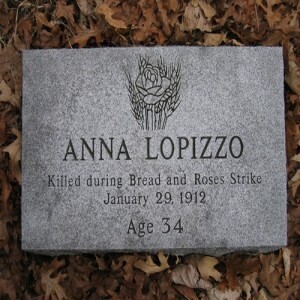

On this day in labor history, the year was 1912.
That was the day striking worker, Anna LoPizzo was shot and killed by local police during the pivotal Bread and Roses strike in Lawrence, Massachusetts.
In what is considered one of the most important strikes in American labor history.
The Industrial Workers of the World had organized a strike that brought out more than 30,000 textile mill workers at the American Woolen Company.
Workers had been on strike for most of the month, picketing, marching, giving speeches and stopping scabs.
Their banners demanded a living wage and dignity: Bread and Roses.
That day, there were workers parades among pitched battles between strikers, police and scabs.
Gunfire erupted.
According to Big Bill Haywood, nineteen witnesses saw Police Officer Oscar Benoit shoot Anna LoPizzo.
But the shooting provided the mill owners with an opportunity to crack down on the strike.
Martial law was instituted and all public meetings and marches were banned.
The leading IWW strike organizers, John Ettor and Arturo Giovannitti were arrested for her murder, despite the fact that they were two miles away from the scene.
Though they were eventually acquitted, their imprisonment removed them from directing the day-to-day work of the strike.
But who was Anna LoPizzo?
According to Bruce Watson, author of Bread and Roses: Mills, Migrants, and the Struggle for the American Dream, “If America had a Tomb of the Unknown immigrant paying tribute to the millions of immigrants known only to God and distant cousins compiling family trees, Anna LoPizzo would be a prime candidate to lie in it.”
And indeed she was for 88 years until retired IBEW 2321 business manager, David Morris worked to get a headstone, decorated with the Bread and Roses symbol–grain stalks and a rose, for her pauper’s grave.
More Episodes
All Episodes>>You may also like
Creat Yourt Podcast In Minutes
- Full-featured podcast site
- Unlimited storage and bandwidth
- Comprehensive podcast stats
- Distribute to Apple Podcasts, Spotify, and more
- Make money with your podcast











